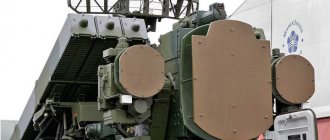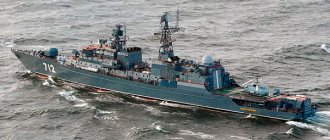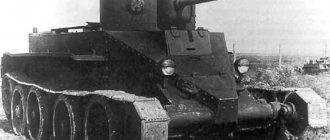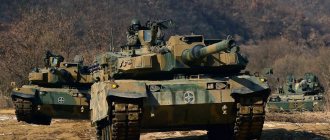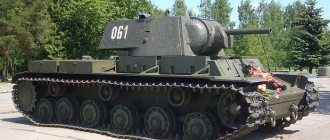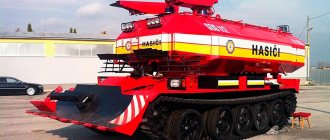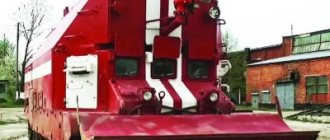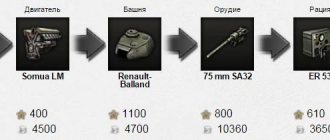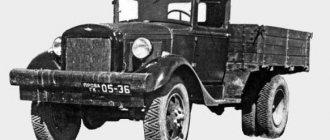Outside and inside
Remember what it was like to sit in economy class on an airplane between two adjacent passengers? It was even worse in the T-34.
No matter how legendary the T-34 was, it was also extremely uncomfortable for people. The interior space of the T-34's cabin was divided into two parts: one for attack and the second for controlling the vehicle. The combat unit was located under the turret - the loader and commander sat in it, and in front of them, almost “in the nose” of the tank, sat the driver and gunner-radio operator. The tank commander was forced to do several things at the same time - he controlled the gun, aimed the sight, monitored the external situation on the battlefield and directed the actions of the entire crew. There was not enough space in the tank's cabin; everyone was crammed together and could not effectively control the vehicle. But later the tank became a five-seater altogether: in order to free the commander from some of the tasks, a gunner joined the crew.
Tanks built at different factories and during different periods of the war could differ in details, but the basics were always the same: an armored hull, a tracked chassis, weapons and an engine.
To ensure strong shell protection for the tank, it was covered with steel plates 45 mm thick at the front and 40 mm thick at the rear. The roof over the engine and transmission compartment was 16 mm thick, and over the turret box it was 20 mm thick. The bottom of the tank in different places was from 13 to 40 mm. Messages were left on many of the buildings: soldiers scratched out their initials or memorable words. Fuel tanks were located on the sides of the tank, a horn and headlight were welded to the front, and a transmission, exhaust pipes and tow hooks were welded to the rear. To repair something, you first had to cope with the task of “opening the hatch” - they were tightly screwed with bolts or closed with pins.
The tank's turret could be different - this also depended on the manufacturer and year of production, but it was always a two-seater. At the beginning of production, the tower was welded from several plates and sheets, and by the end of 1940 they began to cast it entirely. From the beginning of 1942, the tower became wider, more voluminous and slightly changed its shape, becoming similar to a hexagon, which is why it was nicknamed the “hexagon” or “nut”. Despite the increased space, it was still quite cramped for two people. Indeed, in addition to people, it stored all the weapons, observation and sighting devices, a turret rotation mechanism, part of the ammunition, a radio station and TPU devices (tank intercom). On the sides of the tower there were openings for firing from personal weapons and latches for viewing - in addition to the fact that the soldiers attacked with a tank gun, they also had to fire from their machine guns. It happened that the tank commander simply could not use the instruments he needed, since there was no way to reach them. As a result, the tank's controllability and crew coordination suffered.
During non-combat times, the commander observed the situation, leaning completely out of the top hatch.
Nowadays, anyone will have a reasonable question: “Why did they make everything so inconvenient and not for people?” Now the problems of cramped space seem easily solvable - just make the tank wider, but under the conditions of a forced increase in production volumes this was impossible. All innovations (improving the ergonomics and parameters of the tower) required serious changes in the design, and this could only be done in stages without stopping production. This is what they did with the tower, for example, when in 1942 they changed its shape to hexagonal.
Location of internal modules in the tank.
In the front of the tank sits a radio operator and a driver; between them there is a layer of ammunition stowage, but it is protected by a 90 mm thick seam, with a high probability you will not penetrate it. If you shoot at the commander's cupola, you can concuss the commander (aka the gunner), the accuracy of the shots will decrease, and the viewing range will also significantly decrease.
There are fuel tanks on the sides of the tank, which can be easily set on fire if your gun has high one-time damage. At the rear of the hull there is an engine, which, when hit, causes maximum damage to the enemy tank. The commander is located in the tower, and behind him is a large ammo stowage unit, which will not be difficult to damage.
How did you travel?
What made the tank work was in the power section - at the back. Engine, transmission, radiators, fuel tanks, clutches with a fan and everything, without which the “thirty-four” simply will not go. The T-34 engine, an all-diesel uncompressor V-2, was not quite common for those times.
(
more about this in the article “First of its kind: V-2 diesel engine.” – Ed.
). It was given to Soviet developers and engineers through sweat and tears - the history of the engine, like the tank itself, is full of troubles and problems. Fuel was poured into 90-liter tanks on the sides of the vehicle and supplied by NK-1 pumps (cantilever pump). They used winter diesel fuel almost all year round, but if the temperature rose to +5 °C, they could use summer diesel fuel. To prevent the engine from overheating, a liquid cooling system with a total volume of 95 liters was built into the tank - with forced circulation and two tubular radiators on either side of the engine. To clean the engine cylinders of air, at first they used one Pompon air cleaner, but its power was not enough, so after 1942 it was replaced with two Multicyclone air cleaners. The 1940 transmission consisted of a multi-plate dry friction main clutch, a five-speed four-speed gearbox (became a five-speed in '43), final clutches and brakes, brakes and final drives.
The chassis of the tank consists of five road wheels on both sides, each with a diameter of 830 mm, and two wheels – a guide at the front and a drive at the rear. The design of the road wheels could vary significantly: at different times, stamped or cast rollers were used, rubberized either with internal shock absorption or without it at all. The T-34 tracks were cast from steel - it was a series of tracks, alternating and connecting. Tank tracks are like Lego pieces from which a caterpillar was assembled. It reached a width of 500 mm, and one track made a “step” 172 mm long. In the first years of production, the caterpillar had 74 tracks, and later it became 72. Sometimes, in order for the T-34 to get through rough terrain faster and more efficiently, lugs were installed with bolts on every fourth or sixth track.
The entire chassis was attached to the tank hull using a spring suspension known as a Christie suspension - the rollers were connected to springs. Compared to the classic spring suspension, this suspension allowed the tank to drive faster and be slightly smaller in height.
Inside the T-34-85. Photo: Roman Krivov, www.topwar.ru
History[edit]
The T-34 tank was developed by the Kharkov design bureau under the leadership of M.I. Koshkin. From 1942 to 1945, the main large-scale production of the T-34 was launched at powerful machine-building plants in the Urals and Siberia, and continued in the post-war years. The leading plant for modifying the T-34 was the Ural Tank Plant No. 183.
The T-34-76 was a fairly rare export tank compared to the T-34-85, but still found its way to various countries including (but not limited to) North Vietnam, East Germany (who used them primarily for training), Poland , Czechoslovakia and North Korea. Thus, it is likely that among the 1800 T-34 tanks transferred by the USSR to China in the early 50s, there were a number of T-34-76s. After service with the PLA, almost all of them were transferred by the Chinese government to North Korea. Subsequently, under the leadership of Chinese engineers, these machines were modernized by installing a new engine and changing the chassis.
The only mention of the use of the T-34-76 in the Chinese army comes from the video game "World of Tanks" and their Chinese client. Soviet data on arms sales to China between 1950 and 1955 do not support the presence of the T-34-76. Dr. Martin Andrew (PLA historian) reports that in 1950 the PRC received 1,837 T-34-85, 82 IS-2, 40 ISU-122, 67 ISU-152, 99 SU-100 and 704 SU-76 tanks, as well 89 ARVs, some (perhaps even most) were on the T-34 chassis (at least 2 were built on the ISU chassis). These figures are estimates, but other sources have slightly different figures. For example, Zhang Zhiwei (author of The Tank Division of the Chinese People's Liberation Army 1945-1949) claims that the PRC received 1,964 T-34-85s by 1955. Regardless of the exact figures, Dr. M. Andrew reports that there is no evidence that that the PLA received the T-34-76, or any assumptions provided that he is aware of.
And if all these tanks were later provided to North Korea, then two questions arise: “Where are the remains of these tanks?”, and “Why has no evidence been found of modernization of the engines and chassis?”
In fact, North Korea received all of its tanks directly from the USSR in February 1950, when a military advisory group was sent along with small arms, aircraft, artillery and other types of military equipment. This was enough to equip eight field divisions and other fighting units consisting of 100,000 men. Thus, the idea that all North Korean T-34-76s are in fact ex-Chinese has not come to fruition.
The claim that the T-34-76 received Chinese upgrades also sounds extremely dubious. The only known Chinese upgrade to the T-34 was modifications of the T-34-85 to Type 58 standards, which did not include a suspension upgrade. The context of the description in the World of Tanks game does not provide a clear indication of whether the remnants of Chinese tanks or North Korean vehicles were modernized. Some images of North Korean T-34-76s in the post-Korean War era indicate that some minor upgrades were made, such as side-mounted fuel tanks, post-war die-cast external rubber-cushioned road wheels (first introduced by the Soviets in 1969), and possibly , some other small details. It can be assumed that these improvements were developed with Chinese assistance, which gives rise to the claim of Chinese upgrades, but very little is known about the maintenance of North Korean T-34-76s after 1953.
The famous photo of the Type T-34 tank from the Chinese Museum of the Korean War is the main argument in favor of evidence of the existence of a Chinese design. The origin of this car is unknown. Most likely, this is just a modern reconstruction for a museum exhibition.
The tank is made from a mixture of strange parts, such as modernized post-war T-34-85 rollers (almost certainly acquired, since they were made in 1969 at the height of the Sino-Soviet split), T-55 style tracks, a drive wheel also from T-55, the engine compartment handrails are non-standard (possibly handmade), next to the driver's hatch there is a grille from a T-55 spotlight. Most notable is the gun mantlet, which indicates that the tank is an inaccurate museum restoration, and may simply be a Type 58 tank made to look like a T-34-76 using parts that were (possibly) recently acquired. However, the handrails on the hull are typical of the T-34-76 (although they may be handmade), and the position of the machine gun in the hull may also be standard for the T-34-76 tank (this is not entirely clear, since the only indicator these would be castings not visible in these photographs). It is therefore also possible that the hull is a T-34-76 hull that was recently acquired but was nevertheless not accurately restored. It is even possible that this tank was purchased from North Korea, as some modern footage shows that the North Korean T-34 has very similar production characteristics to this T-34.
Therefore, it can be concluded that this tank is a post-Korean War acquisition that has undergone an inaccurate restoration for museum purposes and should not be considered evidence of PLA T-34-76 use.
Kongzhong reportedly has access to Chinese military archives and is providing Wargaming with the information they find to create Chinese tanks for the video game. It is said that Kongzhong consultants can only take personal handwritten notes during research, and materials found in the archive cannot be made public (which is the case in many archives). Thus, the existence of the Type T-34 depends on the word "Kongzhong", which is quite problematic.
Kongzhong is known to often take considerable creative liberties or even completely fabricate Chinese tanks, which means their credibility as a historical source is completely lacking. World of Tanks is also notorious for being filled with fake tanks.
Bottom line, there is no reliable evidence of the existence of the Type T-34 or any of these supposed upgrades in China that is available to non-Chinese historians, with two historical companies of dubious reputation serving as historical sources. One can only conclude that the Type T-34 does not exist until further evidence is presented and evaluated.
How did I contact you?
The Achilles heel of tanks was communications - until 1943, only some command T-34s had radios installed, while most of all German tanks were equipped with two-way radio communications. Due to the fact that the “thirty-four” could not communicate with each other, in the initial stages of the war there were many problems with coordinating actions.
Only in 1943, about 2/3 of the tanks produced were able to be equipped with radio communications, installing 9M radio stations and TPU-3bisF intercoms on them. But for subsequent modifications of the T-34-85, radio communications were installed in all cases. The tank crew communicated through the internal TPU-3-bisF, and the short-wave transceiver telephone radio station 9-RS served for communication between two tanks, the distance between which was no more than 18 km.
Equipment
The choice of equipment for the T-34 will increase the effectiveness of the tank in battle by leveling out its weaknesses and improving the quality of its strengths. This tank is very versatile, so it has several options for choosing additional modules.
Melee:
- medium caliber gun rammer - will increase the reload speed by 10%, thereby increasing the potential damage per minute. The effect will be especially felt in a 1 on 1 shootout;
- improved ventilation Class 2 - a 5% increase in crew skills will slightly increase all the characteristics of the tank;
- reinforced aiming drives - will help to aim faster in order to realize the capabilities of a rapid-fire gun with greater efficiency.
For fans of the aggressive style of play on the front line, the third module can be replaced with coated optics to gain an additional 15 meters of field of view.
Ambush tactics:
- medium caliber gun rammer;
- camouflage net - will improve initially good camouflage, allowing you to remain invisible longer when stationary;
- stereo tube - when stationary, it will add 87.5 meters to the tank’s visibility, which will make it possible to cover allies much more effectively.
How he attacked
The main “argument” of all T-34s was the cannon. In the first years of production (1938–1939), the L-11 was 76 mm and 30.5 caliber long (2324 mm), and an armor-piercing projectile flew out of it at a speed of 612 m/s. Later, in 1941, the cannon (now F-34) was lengthened to 41.5 caliber (3162 mm), and the projectile speed reached 662 m/s. Everything was aimed at improving the attack. The soldier controlled the gun himself, manually. Despite the complexity of this process, there were many clues in the tank - for example, the turret and gun control mechanisms were painted white and green so that they would not be confused in the turmoil of battle.
Ammunition of the T-34-85 tank.
Photo: Roman Krivov, www.topwar.ru Two 7.62-mm DT machine guns, developed by designer Vasily Degtyarev, came to the aid of the cannon in difficult times. One “coaxial” machine gun was placed with the cannon in the same installation, even having the same pointing angle with it, and the second “course” machine gun was mounted on the upper front plate of the tank’s armor. To “catch” the target, on tanks with the L-11 cannon they used the TOD-6 telescopic sight and the PT-6 periscopic panoramic sight for observation from cover. The gun ammunition of both L-11 and F-34 guns was almost identical in composition - 76-mm unitary artillery rounds: the type with a caliber armor-piercing projectile (BR-350A, BR-350B, BR-350BSP); type with a sub-caliber projectile (BR-354P); type with high-explosive fragmentation grenades (OF-350, OF-350A, OF-350V, OF-354). The shots were placed in suitcases at the bottom of the fighting compartment and on its walls. At first, the reserve amounted to 77 rounds, but later, on tanks of 1942–1944, the ammunition load was increased to 100 rounds.
An artillery shot includes several ammunition to be fired: a projectile, a powder propellant charge, and a means of igniting the charge. A unitary shot, like the ones on the T-34, means that loading occurs uniformly - all components are “inserted” into the gun at once.
Due to frequent changes in the design of the T-34, albeit small ones, the crew did not have time to retrain. In his memoirs, Soviet military leader Mikhail Efimovich Katukov Fr.
That's what the T-34 was. On thematic forums and websites they like to compare it with other medium tanks from the war and even with modern ones. They say about him: “There is no English rationality, no American comfort. There is nothing, if you think about it. But there is something that made the T-34 one of the best tanks in the world. Simplicity of the weapon, or something. T-34 is a machine for real combat.”
Gallery[edit]
- An inaccurate reconstruction of a T-34-76 (Type T-34) tank at the Korean War Museum in Dandong, Liaoning Province, China.
- Type T-34 with a 57 mm 55-57FG gun in the game "World of Tanks".
- Type T-34 in the game "World of Tanks".
- Type T-34 in the game "World of Tanks".
- Type T-34 in the game "World of Tanks".
- Type T-34 in the game "World of Tanks".
- Type T-34 in the game "World of Tanks".
- Drawing of the Type T-34 in the game “World of Tanks”.
- Artist's interpretation of the T-34-76 (produced by Factory 174, Omsk), painted in normal PLA colors, based on the T-34-85 shown in the National Day parade in the 1950s.
- Artist's interpretation of the T-34-76 (produced by Factory 174, Omsk), painted in typical PLA camouflage, based on the Chi-Ha and T-26 shown in the PRC parade on October 1, 1949
Brief summary
Overall, the tank is very interesting and easy to learn. In the hands of an experienced player, it really turns into a bending machine and is capable of inflicting a large amount of damage. If you know the vulnerabilities of the equipment, then using a rapid-fire cannon you can inflict increased damage on modules, more often exploding the ammunition rack or setting the enemy on fire.
With the T-34, you can switch to two branches of medium tanks and a branch of light tanks, so it is recommended to open all the equipment at once, so as not to return to level 5 and retrain the crew again (do not forget that the roles of tankers will change later).
